Lisa Dawn's Blog: The Princess Blog, page 74
August 4, 2018
Medieval Times Has a New Queen
At the beginning of the year, I made a post comparing Medieval Times to the similarly themed Pirate's Dinner Adventure. Shortly afterward, I learned that the dinner show at Medieval Times was being rewritten with a queen serving as hostess to replace the king and princess who had led the event in the past. The new plot revolved around the king dying in a war and his daughter taking over the kingdom as queen. It replaced the old version of the show little by little throughout the year at the various Medieval Times castles throughout the country. The actors who played the king retired and the actresses who played the princess were promoted to queen. I knew I needed to see this feminist revival of the story that boasted a new script, new costumes, new lighting, and new music, so I made plans to go back for my birthday. Today, I watched Queen Doña Maria Isabella take her place on the throne to assert her power during the traditional jousting tournament.
Most of the changes to the show were pretty subtle. If you liked it before, you'll probably feel the same way now. If you didn't, there isn't too much new content to sway your interest. The lighting and music changes would only be noticed by those who have gone often and paid very close attention. The knights' costumes look very similar to the way they did before. The queen has a more suitable dress for her new role now that she is no longer a princess. Her new costume had been promoted heavily in photo shoots leading up to the changes at my local castle. All of the promo pictures were breathtaking. Her gold and burgundy brocade gown was a vast improvement over the simplistic medieval princess dress, and her ruby-studded crown and refined makeup command respect for her new status. In person, the dress shined like a beacon of light over the arena. The metallic gold pattern was nearly blinding under the spotlight, making it difficult to look away from her radiance.
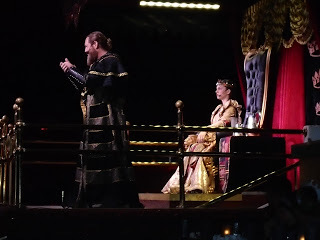
The performances were the same as the previous show, but the pacing felt tighter. They spent less time showing the horses walking around the arena in circles and more time on the actual tournaments. The same falcon lady came out for the first act, and the same colored knights appealed to their separate sections of the audience. At various points during the show, the queen handed roses down to them that they threw to lucky members of the audience. I was in the green section again, and our knight was quite the flirt, kissing each rose before throwing it to a lady. Gone is the knight from an enemy kingdom who appears and threaten to take the princess as his bride by force, angering the king. Instead, the new version has one of the queen's own knights disrespect her authority by insisting on wanting to fight to the death. The queen, as a champion of justice, refuses to allow her knights to resort to such measures because she had already suffered enough through the perils of war. Unfortunately, she is overruled by the audience's desires.
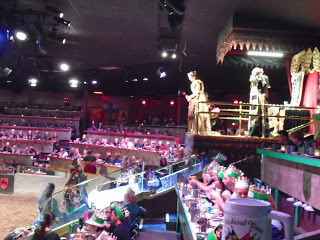
In the previous version of the show, the princess announces the birthdays and celebrations for the people in the audience who paid extra to have their names announced. As queen, she no longer has time for that nonsense, so those duties have been handed down to Lord Cedric, who shares her private viewing space on the balcony. Cedric disapproves of her pacifistic nature but respects her as his queen. He is the first person to ride into the arena at the beginning of the show. What little dialogue there is between tournament games is shared between the two of them. They have some friendly discussions about the competitions between the knights and the affairs of other kingdoms. Though the queen is ultimately forced to give into Cedric and the audience's bloodlust, she asserts her authority beautifully and adds a welcome sense of female empowerment that the princess in the previous show was unable to provide as a second in command to her father.
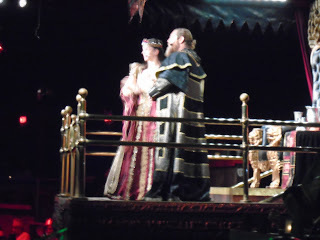
Queen Doña Maria Isabella is the first queen in Medieval Times' 34-year-long run. She has a much stronger female presence than her predecessor did as princess by asserting her disapproval of violence. Her shimmering gown gives girls something beautiful to behold while the horses run around on the stage. Even though I believe these changes are necessary to give the show a wider appeal, I still prefer the Pirate's Dinner Adventure show for having a more solid story and on-stage performances from both of the female characters. Queen Isabella shows us that women are just as capable of holding positions of power as men. In the end, however, Medieval Times is really about the jousting. This is proven further by the lack of care given to the acoustics for the performers. Most of the dialogue is distorted by the poor speaker system, making it difficult to understand what the announcers are saying over all the cheering from the audience. Even though the regal queen is unable to prevent her knights' thirst for blood, she gives it an admirable effort.
Most of the changes to the show were pretty subtle. If you liked it before, you'll probably feel the same way now. If you didn't, there isn't too much new content to sway your interest. The lighting and music changes would only be noticed by those who have gone often and paid very close attention. The knights' costumes look very similar to the way they did before. The queen has a more suitable dress for her new role now that she is no longer a princess. Her new costume had been promoted heavily in photo shoots leading up to the changes at my local castle. All of the promo pictures were breathtaking. Her gold and burgundy brocade gown was a vast improvement over the simplistic medieval princess dress, and her ruby-studded crown and refined makeup command respect for her new status. In person, the dress shined like a beacon of light over the arena. The metallic gold pattern was nearly blinding under the spotlight, making it difficult to look away from her radiance.

The performances were the same as the previous show, but the pacing felt tighter. They spent less time showing the horses walking around the arena in circles and more time on the actual tournaments. The same falcon lady came out for the first act, and the same colored knights appealed to their separate sections of the audience. At various points during the show, the queen handed roses down to them that they threw to lucky members of the audience. I was in the green section again, and our knight was quite the flirt, kissing each rose before throwing it to a lady. Gone is the knight from an enemy kingdom who appears and threaten to take the princess as his bride by force, angering the king. Instead, the new version has one of the queen's own knights disrespect her authority by insisting on wanting to fight to the death. The queen, as a champion of justice, refuses to allow her knights to resort to such measures because she had already suffered enough through the perils of war. Unfortunately, she is overruled by the audience's desires.

In the previous version of the show, the princess announces the birthdays and celebrations for the people in the audience who paid extra to have their names announced. As queen, she no longer has time for that nonsense, so those duties have been handed down to Lord Cedric, who shares her private viewing space on the balcony. Cedric disapproves of her pacifistic nature but respects her as his queen. He is the first person to ride into the arena at the beginning of the show. What little dialogue there is between tournament games is shared between the two of them. They have some friendly discussions about the competitions between the knights and the affairs of other kingdoms. Though the queen is ultimately forced to give into Cedric and the audience's bloodlust, she asserts her authority beautifully and adds a welcome sense of female empowerment that the princess in the previous show was unable to provide as a second in command to her father.

Queen Doña Maria Isabella is the first queen in Medieval Times' 34-year-long run. She has a much stronger female presence than her predecessor did as princess by asserting her disapproval of violence. Her shimmering gown gives girls something beautiful to behold while the horses run around on the stage. Even though I believe these changes are necessary to give the show a wider appeal, I still prefer the Pirate's Dinner Adventure show for having a more solid story and on-stage performances from both of the female characters. Queen Isabella shows us that women are just as capable of holding positions of power as men. In the end, however, Medieval Times is really about the jousting. This is proven further by the lack of care given to the acoustics for the performers. Most of the dialogue is distorted by the poor speaker system, making it difficult to understand what the announcers are saying over all the cheering from the audience. Even though the regal queen is unable to prevent her knights' thirst for blood, she gives it an admirable effort.
Published on August 04, 2018 23:55
August 3, 2018
The Evolution of the Disney Princess Anthem
Yesterday, Disney released a new music video of
The first Disney Princess anthem, called "If You Can Dream," was released as a bonus song on the Disney Princess Sing Along Songs Volume 1 DVD in 2004. The song was alongside a video made entirely of Disney movie clips, something that was very popular at the time. I, myself, had made many Disney Princess fan music videos under the handle of Lady Heartilly. "If You Can Dream" was also a big deal because it was the first time all of the original singing voices of the Disney Princesses got together to perform an original track. It was very similar to what the Wreck-It Ralph sequel is doing with spoken dialogue. The song was a beautiful arrangement with lovely instrumentals and breath-taking harmonies by some of the most beloved princess voice artists. Its lyrics were a little cheesy, often borrowing from each princess's most famous song, with lines such as "It's a tale as old as time," "The colors of the wind will lead my heart right back to you," and "There's a whole new world waiting there for us." The song matched the themes represented by the Disney Princess movies leading up to the late '90s, but it quickly became outdated after the turn of the century, which is why it didn't get as much publicity as it arguably deserved.
On the second Disney Princess Sing Along DVD in 2005, there was a similar music video mash-up called "Where Dreams Begin." This one did not catch on nearly as well as "If You Can Dream," on account of having an unknown singer and an overly synthesized sound to it. It wasn't the worst song in the world, but the melody did not scream "Disney Princess" like its predecessor did. The lyrics were pretty similar, but they were a bit more modern and generic. "Where Dreams Begin" was the first Disney Princess anthem that sounded like it could be a Disney Channel pop song, even though I'm not sure if it ever actually aired on Disney Channel. Since it never quite caught on, "If You Can Dream" was still generally accepted as the Disney Princess anthem for the following decade until the "Dream Big, Princess" campaign in 2016, where it was replaced with "Hall of Fame" by The Script featuring will.i.am. This song had an enormous marketing platform with tons of Disney Princess mash-up videos all over social media, causing it to overshadow the outdated "If You Can Dream."
I always thought "Hall of Fame" was an odd choice for a Disney Princess anthem, as it clearly wasn't written for that purpose. The song was released about five years before Disney started using it for their campaign, and the lyrics don't apply directly to the Disney Princess movies. It's pretty obvious that Disney only used it to try to create a wider appeal for their princesses and show the world that they were rejecting their old themes that could be considered anti-feminist by some people, such as needing to be rescued and find love. Of course, the presumed negative effects of princess culture on society are highly debatable. The thing that bothered me the most about "Hall of Fame" is that the song was performed entirely by male singers when it was supposed to promoting female empowerment. Sure, it was played over footage of girls being active and doing impressive feats such as scuba diving, rock climbing, and winning races, but wouldn't it make more sense to back up those images with an empowering female voice? I guess someone at Disney finally realized that out a few months ago because the song was replaced earlier this year with "Live Your Story."
"Live Your Story" was written and performed by an unknown singer (at least to me) named Tina Parol. It was a better fit for the Disney Princess movies than "Hall of Fame" on account of the fact that the lyrics were actually written to fit the "Dream Big, Princess" campaign. The footage of girls being active was very similar to that of the previous music video, but now it was accompanied by a female performer telling girls to "dream, see, write, live your story." This makes more sense than "standing in the hall of fame" because the Disney Princesses were never in competition with other people. They were princesses because they were either born into it or married into it. "Live Your Story" is more about dreaming of adventure and love and actively pursuing what you want. I like that the song reminds us that most of these movies originated from stories that are several hundred years old. Disney Princesses inspire girls to go on adventures and write their own story exactly as the song states. The only thing that was missing from the good old days of "If You Can Dream" was the voice of an original Disney Princess. Having Auli'i Cravalho release a cover of it resolves that issue. I appreciate that Disney continues to update their movies to match with modern feminist ideals, but I still miss the calming instrumentals and harmonizing vocals of "If You Can Dream."
The first Disney Princess anthem, called "If You Can Dream," was released as a bonus song on the Disney Princess Sing Along Songs Volume 1 DVD in 2004. The song was alongside a video made entirely of Disney movie clips, something that was very popular at the time. I, myself, had made many Disney Princess fan music videos under the handle of Lady Heartilly. "If You Can Dream" was also a big deal because it was the first time all of the original singing voices of the Disney Princesses got together to perform an original track. It was very similar to what the Wreck-It Ralph sequel is doing with spoken dialogue. The song was a beautiful arrangement with lovely instrumentals and breath-taking harmonies by some of the most beloved princess voice artists. Its lyrics were a little cheesy, often borrowing from each princess's most famous song, with lines such as "It's a tale as old as time," "The colors of the wind will lead my heart right back to you," and "There's a whole new world waiting there for us." The song matched the themes represented by the Disney Princess movies leading up to the late '90s, but it quickly became outdated after the turn of the century, which is why it didn't get as much publicity as it arguably deserved.
On the second Disney Princess Sing Along DVD in 2005, there was a similar music video mash-up called "Where Dreams Begin." This one did not catch on nearly as well as "If You Can Dream," on account of having an unknown singer and an overly synthesized sound to it. It wasn't the worst song in the world, but the melody did not scream "Disney Princess" like its predecessor did. The lyrics were pretty similar, but they were a bit more modern and generic. "Where Dreams Begin" was the first Disney Princess anthem that sounded like it could be a Disney Channel pop song, even though I'm not sure if it ever actually aired on Disney Channel. Since it never quite caught on, "If You Can Dream" was still generally accepted as the Disney Princess anthem for the following decade until the "Dream Big, Princess" campaign in 2016, where it was replaced with "Hall of Fame" by The Script featuring will.i.am. This song had an enormous marketing platform with tons of Disney Princess mash-up videos all over social media, causing it to overshadow the outdated "If You Can Dream."
I always thought "Hall of Fame" was an odd choice for a Disney Princess anthem, as it clearly wasn't written for that purpose. The song was released about five years before Disney started using it for their campaign, and the lyrics don't apply directly to the Disney Princess movies. It's pretty obvious that Disney only used it to try to create a wider appeal for their princesses and show the world that they were rejecting their old themes that could be considered anti-feminist by some people, such as needing to be rescued and find love. Of course, the presumed negative effects of princess culture on society are highly debatable. The thing that bothered me the most about "Hall of Fame" is that the song was performed entirely by male singers when it was supposed to promoting female empowerment. Sure, it was played over footage of girls being active and doing impressive feats such as scuba diving, rock climbing, and winning races, but wouldn't it make more sense to back up those images with an empowering female voice? I guess someone at Disney finally realized that out a few months ago because the song was replaced earlier this year with "Live Your Story."
"Live Your Story" was written and performed by an unknown singer (at least to me) named Tina Parol. It was a better fit for the Disney Princess movies than "Hall of Fame" on account of the fact that the lyrics were actually written to fit the "Dream Big, Princess" campaign. The footage of girls being active was very similar to that of the previous music video, but now it was accompanied by a female performer telling girls to "dream, see, write, live your story." This makes more sense than "standing in the hall of fame" because the Disney Princesses were never in competition with other people. They were princesses because they were either born into it or married into it. "Live Your Story" is more about dreaming of adventure and love and actively pursuing what you want. I like that the song reminds us that most of these movies originated from stories that are several hundred years old. Disney Princesses inspire girls to go on adventures and write their own story exactly as the song states. The only thing that was missing from the good old days of "If You Can Dream" was the voice of an original Disney Princess. Having Auli'i Cravalho release a cover of it resolves that issue. I appreciate that Disney continues to update their movies to match with modern feminist ideals, but I still miss the calming instrumentals and harmonizing vocals of "If You Can Dream."
Published on August 03, 2018 11:06
July 30, 2018
How To Be a Princess in Kingdom Hearts Union X
Kingdom Hearts Union X [cross] is a cell phone game that was originally released in America under the name Kingdom Hearts Unchained. It allows you to create a custom avatar and travel through the Disney movies to become a keyblade master. Even though it takes place within the canon Kingdom Hearts universe, it has many distinctive differences from the other games. First, this game is completely free to anyone who has a smart phone. There are certain bonuses that you can spend real money on, but it is absolutely possible to master the game without spending anything. Also, instead of playing as one of the main heroes from the Kingdom Hearts universe, you can essentially be anyone you want. You can name your character, decide if you want them to be male or female, choose a face and skin tone, and unlock tons of hairstyles, costumes, accessories, and descriptive titles throughout the game. Since I had so many options, I did everything I could to make my character as princess-like as possible.
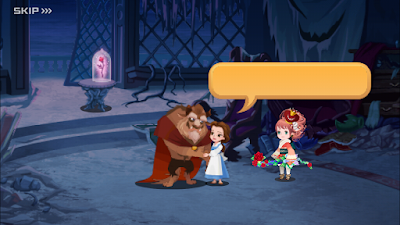
The easiest step to being a princess in Kingdom Hearts Union X is to choose a princess name. It's best to pick one that's well-known so that other party members will get the reference right away. I named my character Ariel after my favorite Disney Princess. There are tons of descriptive titles you can unlock for your character that could apply to a princess such as "Darling," "Cherished," "Beloved," etc. There is also a "Princess" title, but according to my research, you need to log in for eight days in a row in order to unlock it, and I have only been playing for seven. I already unlocked "Prince," "Queen," "Queenly," and "Monarch." It just goes to show that you can become the most powerful player, but a true princess must also master the art of patience. Another great way to be a princess is by unlocking different "Avatar Boards" for your character that contain costume sets and hairstyles by spending "Avatar Coins" that you receive by playing the game often and leveling up. My favorite hairstyle that I've unlocked is called "Formal." It shows up as a high ponytail with large curls spiraling out all around it and small specks of stardust sprinkled inside them.
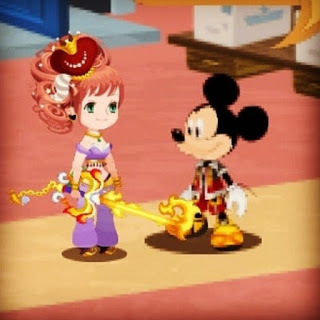
The first princess Avatar Board you can unlock by leveling up is called "Arabian Amythest." It resembles the purple outfit that Princess Jasmine wore at the very end of Aladdin. In the above image, I replaced her jeweled headband with a more eye-catching crown from a Queen of Hearts costume that is currently being promoted for purchase through in-game jewel currency, which is earned by playing the game a lot. Right now, all of the Avatar Boards that you can purchase with jewels are from Alice in Wonderland, including two versions of Alice's dress, a playing card, and a Mad Hatter costume. It looks like the game rotates its premium Disney character costumes every two weeks or so, as they cannot be earned just by leveling up. I've found a list of them here. It appears that in addition to Alice, Avatar Boards for Cinderella, Belle, Ariel, Moana, Megara, Minnie Mouse, Kairi, and alternate versions of Jasmine have been available at some point in the past, so it's certainly possible to play the game looking like a real Disney Princess if you keep an eye on the Avatar Board rotations. I can't wait for the Ariel one to become available again! In the mean time, there are a few other dresses that you can unlock by leveling up, such as Japanese kimono and a Gothic Lolita-style demon dress..
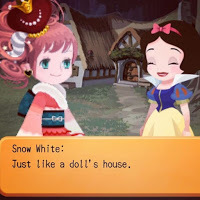
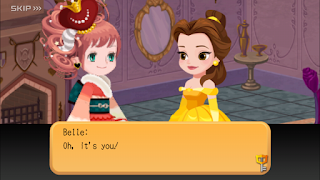
Another thing that made me feel like a princess in Kingdom Hearts Union X was my charater becoming friends with all the Disney Princesses. In the first Kingdom Hearts game, most of the Princesses of Heart get kidnapped before Sora has a chance to meet them. When he finally does, they are all separated from their worlds and are too busy trying to use their light to prevent the world from being taken over by darkness to talk much. In this game, you stand alongside them throughout their stories and step forth to fight anything that gets in their way. There are some things about the timeline that don't make sense because this game is supposed to be a prequel to when these stories took place, but that's explained later when you meet a character called Ephemer who tells you that all of Disney worlds are just projections. It's also kind of weird that no one ever questions how you got into Cinderella's chateau, the Beast's Castle or other private residences without an invitation, but it's fun to imagine without having to work out all the details. Five of the six worlds in the app belong to official Princesses of Heart--Wonderland (Alice in Wonderland), Dwarf Woodlands (Snow White and the Seven Dwarfs), Beast's Castle (Beauty and the Beast), Agrabah (Aladdin), Castle of Dreams (Cinderella) and Enchanted Dominion (Sleeping Beauty). The sixth world is the Olympus Coliseum from Hercules.
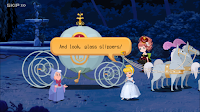
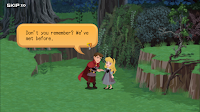
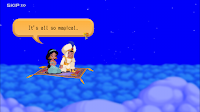
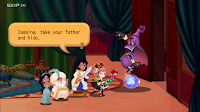
Most of the dialogue in the Disney worlds are lifted directly out of the movies, unlike in the other Kingdom Hearts games, where the characters say things that relate more to Sora and the Heartless. It's a lot of fun being able to play as someone who can step into Disney movies without getting in the way. The game makes it clear that your character is only there to fight monsters and not interfere with the story. For instance, when Aladdin releases the Genie and your character introduces herself, he says he's only talking to the guy with the lamp. I did get a kick out of the part where the Grand Duke from Cinderella asked my character to try on the glass slipper but changed his mind when she took too long to take off her shoes. She looked just as eager to try it on as I would have been. Your lack of direct interaction with the Disney movies results in your charater becoming lonely, which plays into the game's main subplot of becoming friends with Ephemer and wanting to protect the other keyblade wielders. Unfortunately, the American version of the game cut a lot of the dialgoue revolving around Keyblade War and reduced it to a short flashback sequence, but you can get a terrific abridged version of the story from Everglow's YouTube channel.
Even though I still need to wait another day to earn my "Princess" title, Kingdom Hearts Union X made me feel like a real Disney Princess by giving me the opportunity to create a custom character and play dress-up in the worlds of some of my favorite characters. I recommend this game to anyone who has a smart phone and loves princesses. Be careful though! It can become very addictive. There are over 700 story quests available so far, and I completed them in a matter of days. The game lets you skip over quests that don't have cutscenes, which is very helpful if you're only playing for the story. It's easy to win the battles and doesn't require much strategy, especially if you use your jewels to purchase some powerful medals at the in-game shop. If you're wondering which union to join, the Vulpes are led by Lady Ava, who is by far the most princess-like union leader in the game. Her backstory, along with the others, was revealed in the Kingdom Hearts X Back Cover cutscenes, which you can also find on YouTube.

The easiest step to being a princess in Kingdom Hearts Union X is to choose a princess name. It's best to pick one that's well-known so that other party members will get the reference right away. I named my character Ariel after my favorite Disney Princess. There are tons of descriptive titles you can unlock for your character that could apply to a princess such as "Darling," "Cherished," "Beloved," etc. There is also a "Princess" title, but according to my research, you need to log in for eight days in a row in order to unlock it, and I have only been playing for seven. I already unlocked "Prince," "Queen," "Queenly," and "Monarch." It just goes to show that you can become the most powerful player, but a true princess must also master the art of patience. Another great way to be a princess is by unlocking different "Avatar Boards" for your character that contain costume sets and hairstyles by spending "Avatar Coins" that you receive by playing the game often and leveling up. My favorite hairstyle that I've unlocked is called "Formal." It shows up as a high ponytail with large curls spiraling out all around it and small specks of stardust sprinkled inside them.

The first princess Avatar Board you can unlock by leveling up is called "Arabian Amythest." It resembles the purple outfit that Princess Jasmine wore at the very end of Aladdin. In the above image, I replaced her jeweled headband with a more eye-catching crown from a Queen of Hearts costume that is currently being promoted for purchase through in-game jewel currency, which is earned by playing the game a lot. Right now, all of the Avatar Boards that you can purchase with jewels are from Alice in Wonderland, including two versions of Alice's dress, a playing card, and a Mad Hatter costume. It looks like the game rotates its premium Disney character costumes every two weeks or so, as they cannot be earned just by leveling up. I've found a list of them here. It appears that in addition to Alice, Avatar Boards for Cinderella, Belle, Ariel, Moana, Megara, Minnie Mouse, Kairi, and alternate versions of Jasmine have been available at some point in the past, so it's certainly possible to play the game looking like a real Disney Princess if you keep an eye on the Avatar Board rotations. I can't wait for the Ariel one to become available again! In the mean time, there are a few other dresses that you can unlock by leveling up, such as Japanese kimono and a Gothic Lolita-style demon dress..


Another thing that made me feel like a princess in Kingdom Hearts Union X was my charater becoming friends with all the Disney Princesses. In the first Kingdom Hearts game, most of the Princesses of Heart get kidnapped before Sora has a chance to meet them. When he finally does, they are all separated from their worlds and are too busy trying to use their light to prevent the world from being taken over by darkness to talk much. In this game, you stand alongside them throughout their stories and step forth to fight anything that gets in their way. There are some things about the timeline that don't make sense because this game is supposed to be a prequel to when these stories took place, but that's explained later when you meet a character called Ephemer who tells you that all of Disney worlds are just projections. It's also kind of weird that no one ever questions how you got into Cinderella's chateau, the Beast's Castle or other private residences without an invitation, but it's fun to imagine without having to work out all the details. Five of the six worlds in the app belong to official Princesses of Heart--Wonderland (Alice in Wonderland), Dwarf Woodlands (Snow White and the Seven Dwarfs), Beast's Castle (Beauty and the Beast), Agrabah (Aladdin), Castle of Dreams (Cinderella) and Enchanted Dominion (Sleeping Beauty). The sixth world is the Olympus Coliseum from Hercules.




Most of the dialogue in the Disney worlds are lifted directly out of the movies, unlike in the other Kingdom Hearts games, where the characters say things that relate more to Sora and the Heartless. It's a lot of fun being able to play as someone who can step into Disney movies without getting in the way. The game makes it clear that your character is only there to fight monsters and not interfere with the story. For instance, when Aladdin releases the Genie and your character introduces herself, he says he's only talking to the guy with the lamp. I did get a kick out of the part where the Grand Duke from Cinderella asked my character to try on the glass slipper but changed his mind when she took too long to take off her shoes. She looked just as eager to try it on as I would have been. Your lack of direct interaction with the Disney movies results in your charater becoming lonely, which plays into the game's main subplot of becoming friends with Ephemer and wanting to protect the other keyblade wielders. Unfortunately, the American version of the game cut a lot of the dialgoue revolving around Keyblade War and reduced it to a short flashback sequence, but you can get a terrific abridged version of the story from Everglow's YouTube channel.
Even though I still need to wait another day to earn my "Princess" title, Kingdom Hearts Union X made me feel like a real Disney Princess by giving me the opportunity to create a custom character and play dress-up in the worlds of some of my favorite characters. I recommend this game to anyone who has a smart phone and loves princesses. Be careful though! It can become very addictive. There are over 700 story quests available so far, and I completed them in a matter of days. The game lets you skip over quests that don't have cutscenes, which is very helpful if you're only playing for the story. It's easy to win the battles and doesn't require much strategy, especially if you use your jewels to purchase some powerful medals at the in-game shop. If you're wondering which union to join, the Vulpes are led by Lady Ava, who is by far the most princess-like union leader in the game. Her backstory, along with the others, was revealed in the Kingdom Hearts X Back Cover cutscenes, which you can also find on YouTube.
Published on July 30, 2018 10:57
July 29, 2018
Review: The Autumn Fairy of Ages
The Autumn Fairy of Ages
is the sequel to The Autumn Fairy by Brittany Fichter. It's pretty similar to the first book aside from a new setting. Where The Autumn Fairy took place in the human world where Katy was raised and fell in love with her childhood friend, Peter, The Autumn Fairy of Ages takes place in the enchanted world of the fae where Katy hopes to find her new home. I appreciated that the book contained a brief in-universe explanation of why the spelling of the word "faeries" was changed to "fairies" in most contemporary prose even though it was derived from the word "fae" because "humans have trouble pronouncing it." For the most part, I would say that anyone who enjoyed the first book will probably enjoy this one as well. It introduced a lot of new characters, but not a whole lot has changed for the ones we know. Katy and Peter are still fighting against societal norms to prove their love for each other, and Katy still feels like an outcast because of the unusual circumstances of her birth.

One thing I've noticed about Brittany Fichter's writing is that she creates complex new worlds full of unique customs and language without ever explaining any of them to the reader. I was hoping that a book about a new world that was so foreign to both of the main characters would contain more lessons about how fae culture works, but instead, Katy and Peter struggled just as much to understand all of it as I did and even broke several rules without even realizing it. There were certain things that I never quite understood about Peter's role in the fae realm. He was described as a "rhin," which is apparently a king, and was supposed to have a seat on the council with several other rhins and kneel before a magical tree that would help the fae maintain their islands even though the rhins were human Conversely, I completely understood Katy's role among the fae as the first Autumn fairy in centuries because they needed fairies from all four seasons to complete their rituals and save their land. When Katy mentioned that she wanted to do a good job to make Peter look good, the logistics became kind of muddled. Even some of the other fairies admitted that the council didn't care at all about Peter and only wanted Katy for her unique powers.
For the most part, Katy and Peter's relationship stayed as strong as ever after the events of the first book, but they were still tested. The only thing that even came close to pulling them apart was the question of whether or not they would be able to procreate due to one of them being a fairy. I personally could not relate to this struggle because I don't think the ability to bear children should affect who can fall in love with each other, but I understand that Brittany Fichter is religious and incorporates that into her writing, so it didn't come as too much of a surprise that it would be a challenge for the main characters. I also understood why the fairy council was against their marriage in favor of the potential of creating more Autumn fairies, but I didn't think that it should have made Katy and Peter doubt their love for each other. Peter did go overboard with his affections a few times at the beginning of the book by trying to please Katy at the expense of their good image for the council, but that was only a testament to how much more he valued love over power even though it made him seem less than worthy of his role.
My favorite aspect of The Autumn Fairy of Ages was the setting. Katy and Peter were both given beautiful rooms that magically incorporated elements of nature such as flowers, trees, sand, waterfalls, and the ocean. The descriptions reminded me of something straight out of one of the Barbie movies. Fairy fashion also matched that of what we would traditionally imagine for fairy clothing, such as short skirts made of petals or tree bark, leafy corsets, and gowns covered in blossoms. I wish the book had more descriptions of the setting because I love dreaming about other worlds. The surprise ending also impressed me. I can't believe I never saw it coming. It made sense to end with something shocking because the series is supposed to be a trilogy, so it was necessary to build up tot eh final book. Of all the characters who could have been hiding a secret, this one was the most likely. It was brilliantly developed throughout the novel so the reader would gasp when they reached the ending and wonder why they didn't realize it sooner.
The Autumn Fairy of Ages is a worthy sequel to The Autumn Fairy. It's an obvious next step for Katy's journey. Since we already explored Katy's experience in the human world, it would only make sense that we should be able to see how she would fare in the fairy world that she was born into as well. Her relationship with Peter was texted again and still remained strong. Though I enjoyed the descriptions of fae culture, there were certain aspects that I wished the author had elaborated on. It was difficult to just jump into a new world without knowing anything. My pre-order of the book was filled with typographical errors, but the author sent me a proofread copy free of charge when she realized that her editor had jumped the gun. Overall, I would say that anyone who enjoyed The Autumn Fairy would enjoy reading about the next part of Katy's journey just as much.

One thing I've noticed about Brittany Fichter's writing is that she creates complex new worlds full of unique customs and language without ever explaining any of them to the reader. I was hoping that a book about a new world that was so foreign to both of the main characters would contain more lessons about how fae culture works, but instead, Katy and Peter struggled just as much to understand all of it as I did and even broke several rules without even realizing it. There were certain things that I never quite understood about Peter's role in the fae realm. He was described as a "rhin," which is apparently a king, and was supposed to have a seat on the council with several other rhins and kneel before a magical tree that would help the fae maintain their islands even though the rhins were human Conversely, I completely understood Katy's role among the fae as the first Autumn fairy in centuries because they needed fairies from all four seasons to complete their rituals and save their land. When Katy mentioned that she wanted to do a good job to make Peter look good, the logistics became kind of muddled. Even some of the other fairies admitted that the council didn't care at all about Peter and only wanted Katy for her unique powers.
For the most part, Katy and Peter's relationship stayed as strong as ever after the events of the first book, but they were still tested. The only thing that even came close to pulling them apart was the question of whether or not they would be able to procreate due to one of them being a fairy. I personally could not relate to this struggle because I don't think the ability to bear children should affect who can fall in love with each other, but I understand that Brittany Fichter is religious and incorporates that into her writing, so it didn't come as too much of a surprise that it would be a challenge for the main characters. I also understood why the fairy council was against their marriage in favor of the potential of creating more Autumn fairies, but I didn't think that it should have made Katy and Peter doubt their love for each other. Peter did go overboard with his affections a few times at the beginning of the book by trying to please Katy at the expense of their good image for the council, but that was only a testament to how much more he valued love over power even though it made him seem less than worthy of his role.
My favorite aspect of The Autumn Fairy of Ages was the setting. Katy and Peter were both given beautiful rooms that magically incorporated elements of nature such as flowers, trees, sand, waterfalls, and the ocean. The descriptions reminded me of something straight out of one of the Barbie movies. Fairy fashion also matched that of what we would traditionally imagine for fairy clothing, such as short skirts made of petals or tree bark, leafy corsets, and gowns covered in blossoms. I wish the book had more descriptions of the setting because I love dreaming about other worlds. The surprise ending also impressed me. I can't believe I never saw it coming. It made sense to end with something shocking because the series is supposed to be a trilogy, so it was necessary to build up tot eh final book. Of all the characters who could have been hiding a secret, this one was the most likely. It was brilliantly developed throughout the novel so the reader would gasp when they reached the ending and wonder why they didn't realize it sooner.
The Autumn Fairy of Ages is a worthy sequel to The Autumn Fairy. It's an obvious next step for Katy's journey. Since we already explored Katy's experience in the human world, it would only make sense that we should be able to see how she would fare in the fairy world that she was born into as well. Her relationship with Peter was texted again and still remained strong. Though I enjoyed the descriptions of fae culture, there were certain aspects that I wished the author had elaborated on. It was difficult to just jump into a new world without knowing anything. My pre-order of the book was filled with typographical errors, but the author sent me a proofread copy free of charge when she realized that her editor had jumped the gun. Overall, I would say that anyone who enjoyed The Autumn Fairy would enjoy reading about the next part of Katy's journey just as much.
Published on July 29, 2018 12:45
July 25, 2018
Review: A Beautiful Curse
A Beautiful Curse
was the last book I read in the Entwined Tales series, and it might just be my favorite. The sample I read from author Kenley Davidson at the launch party was a novella called
The Countess and the Frog
. I liked the progressive characters as well as the humor, but it was lacking in magic and whimsy. A Beautiful Curse contained all of that and more, which made Davidson's writing truly shine. It was based on the fairy tale "The Frog Bride" by the Brothers Grimm, which, though similar, is not exactly a reverse telling of "The Frog King." Instead of teaching a message about responsibility, "The Frog Bride" is about embracing your differences. It tells the story of three princes who must pass a series of tests to inherit the throne from their father. The youngest prince, who is considered the good-for-nothing runt of the family, passes the tests by taking advice from a talking frog he meets in the woods that turns out to be a beautiful princess. The story served as inspiration for one of my own fairy tales. I liked the characters from "The Frog Bride" it a little more than the ones in "The Frog King," since unlike the latter, it did not contain a whiny spoiled princess.
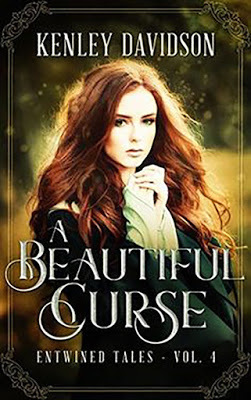
A Beautiful Curse tells the story of Elisette, the middle child of the fairy godfather-cursed family from the series. When they were born, their bumbling fairy godfather, Mortimer, gave her and her twin brother, Martin, the gift of beauty. Unfortunately, he could not have picked a worse set of twins to grant it to. Martin, who is seen briefly in a A Little Mermaid , hates being beautiful because it causes people to think that he's a girl. Elisette, on the other hand, grows up with absolutely no interest in any of the things a woman with her gift could benefit from. She doesn't care much for fashion, romance, dancing, or courting. Instead, she is a bookworm who wishes to have a career. Her parents' misguided attempts to help her by convincing her to embrace her beauty and find a suitor only frustrate her. So, she applies to be a librarian's apprentice at a famous library in the capital under the name "Eli." Unfortunately, it's not that easy to escape the burden of her beauty. Once she reveals her face to her employers, she is hired with the utmost reluctance as her co-workers regularly sabotage her work in any way they can, hoping to get her fired.
Meanwhile, the three princes of the kingdom are put to the test by their father, the king. Though the youngest son, Cambren, is not mocked as openly as he is in the original fairy tale, he is still considered the oddball of the family. His brothers are especially annoyed with him when they visit the local library to learn if the rumors of the beautiful new apprentice are true, and he has the nerve to ask her to help him find a book! To Elisette's dismay, such a request does turn out to be an uncommon occurrence when she finds that the library quickly becomes crowded with people who want to look at her and have no interest in reading. It gets so bad that she gets put on probation for causing too many distractions for the library's patrons. Elisette can't understand why it's so hard for her to just do her job, especially after all the work she put into it. She begs Mortimer for help but quickly regrets it when she is transformed into a slimy frog right in the middle of the library!
Prince Cambren's oddities come in handy for Elisette when he decides to scoop up the cursed frog and protect it instead of running away screaming like the others. In return, Elisette agrees to help Cambren with his father's tests but refuses to tell him who she really is. She has never known a man to respect her after seeing her face, so she feels that it is best for him to think that she is a talking frog. This doesn't prevent them from getting to know each other on an intellectual level and growing very close. It's touching how protective Cambren is of the frog without even knowing she is a woman, let alone one who helped him find a rare book he had been searching for earlier. The romance in this book was built at a perfect pace and contained the timeless themes of "Beauty and the Beast" that true beauty is found within.
A Beautiful Curse did a fantastic job of conveying the overall theme of the Enchanted Tales series that magical gifts that seem harmless can become curses if they are given to the wrong person. Elisette was by far the strongest and most interesting heroine in all of the books. She had the clearest goals and the most rational plan for attaining them. The romance was done equally well and teaches us that love isn't any easier for conventionally beautiful women than it is for anyone else. If you only read one book from Entwined Tales, make it this one.

A Beautiful Curse tells the story of Elisette, the middle child of the fairy godfather-cursed family from the series. When they were born, their bumbling fairy godfather, Mortimer, gave her and her twin brother, Martin, the gift of beauty. Unfortunately, he could not have picked a worse set of twins to grant it to. Martin, who is seen briefly in a A Little Mermaid , hates being beautiful because it causes people to think that he's a girl. Elisette, on the other hand, grows up with absolutely no interest in any of the things a woman with her gift could benefit from. She doesn't care much for fashion, romance, dancing, or courting. Instead, she is a bookworm who wishes to have a career. Her parents' misguided attempts to help her by convincing her to embrace her beauty and find a suitor only frustrate her. So, she applies to be a librarian's apprentice at a famous library in the capital under the name "Eli." Unfortunately, it's not that easy to escape the burden of her beauty. Once she reveals her face to her employers, she is hired with the utmost reluctance as her co-workers regularly sabotage her work in any way they can, hoping to get her fired.
Meanwhile, the three princes of the kingdom are put to the test by their father, the king. Though the youngest son, Cambren, is not mocked as openly as he is in the original fairy tale, he is still considered the oddball of the family. His brothers are especially annoyed with him when they visit the local library to learn if the rumors of the beautiful new apprentice are true, and he has the nerve to ask her to help him find a book! To Elisette's dismay, such a request does turn out to be an uncommon occurrence when she finds that the library quickly becomes crowded with people who want to look at her and have no interest in reading. It gets so bad that she gets put on probation for causing too many distractions for the library's patrons. Elisette can't understand why it's so hard for her to just do her job, especially after all the work she put into it. She begs Mortimer for help but quickly regrets it when she is transformed into a slimy frog right in the middle of the library!
Prince Cambren's oddities come in handy for Elisette when he decides to scoop up the cursed frog and protect it instead of running away screaming like the others. In return, Elisette agrees to help Cambren with his father's tests but refuses to tell him who she really is. She has never known a man to respect her after seeing her face, so she feels that it is best for him to think that she is a talking frog. This doesn't prevent them from getting to know each other on an intellectual level and growing very close. It's touching how protective Cambren is of the frog without even knowing she is a woman, let alone one who helped him find a rare book he had been searching for earlier. The romance in this book was built at a perfect pace and contained the timeless themes of "Beauty and the Beast" that true beauty is found within.
A Beautiful Curse did a fantastic job of conveying the overall theme of the Enchanted Tales series that magical gifts that seem harmless can become curses if they are given to the wrong person. Elisette was by far the strongest and most interesting heroine in all of the books. She had the clearest goals and the most rational plan for attaining them. The romance was done equally well and teaches us that love isn't any easier for conventionally beautiful women than it is for anyone else. If you only read one book from Entwined Tales, make it this one.
Published on July 25, 2018 09:30
July 24, 2018
I Reread The Princess Diaries After Revisiting the Movie
I have kind of a strange relationship with The Princess Diaries. I saw the Disney movie when it came out in 2001 and more or less forgot about it for at least five years until I had several hours to kill at Barnes & Nobles one day and read the a handful of the books by Meg Cabot. So, unlike many fans of the series, I didn't get into the books as a result of the movie or vice versa. I simply happened upon them at different times because I was bored and looking for entertainment. Don't get me wrong; I have nothing against The Princess Diaries. It just isn't one of my favorite live-action princess movies. It wasn't until at least another five years after I read the books that I saw the movie again, so there had been too much time between viewings for me to properly compare the two mediums even though I knew Disney had changed a lot of the source material. I decided to remedy that yesterday and by rereading the first book shortly after another viewing of the film on Netflix. Here's what I learned.

Book Mia and movie Mia seem to live in parallel alternate realities where everything is the same, but inverted. Book Mia lives on the east coast in New York City, while movie Mia lives on the west coast in San Francisco. Book Mia sees her dad on a fairly regular basis and wishes she saw a lot less of her "grandmére," who is basically a clone of Virginia's grandmother from The Tenth Kingdom . Conversely, movie Mia has a dead father who we know nothing about and didn't meet her grandmother until she was in high school, when she found out it was Julie Andrews, who also happens to be a queen. Book Mia is blonde. Movie Mia is a brunette. Book Mia is an immature 14-year-old, while movie Mia is a relatively mature 15-year old. Book Mia is a strict vegetarian, and movie Mia introduces her grandmother to corn dogs. Are any of these differences better or worse? Not really. They just set the Disney movie aside as its own thing, and honestly, the changes work well for the mediums they were associated with.
One thing that surprised me when I read Meg Cabot's book again was how juvenile it was. It's classified as young adult, but reading it made me feel like I was back in elementary or middle school. The books are written like actual diaries from the perspective of a 14-year-old who thinks and acts more like a 12-year-old. The first book came out in the year 2000 and might be a product of its time. Kids are growing up a lot faster today, which is why we have shows about incredibly mature 13-year-olds like Andi Mack. (By the way, you should totally watch Andi Mack if you haven't already because it's amazing). Mia's best friend Lilly was pretty similar in both the book and the movie as a new age "social justice warrior," which is something that became even more common among her age group in subsequent years, so in that respect, the books were right on track. I guess Disney thought that Lilly's militant progressiveness was too much when combined with Mia's militant vegetarianism because they left her dietary preferences out of the movie entirely, even though it removed a major scene in the book where she proves that the vapid hottie Josh doesn't know her at all when he ordered meat for her, replacing it with his inability to make her foot "pop" due to kissing her in a place where her ankles got all tangled in wires.
Overall, I think that most of the changes Disney made in order to convert The Princess Diaries into a movie work in its favor. The diary format of the book resulted in an episodic and disjointed story that only made sense from Mia's perspective. Disney decided to forgo that format entirely and write the movie as a fluid three-act screenplay with pristine pacing and a grander climax, which makes sense because it wasn't supposed to be a series like the books were. In fact, I might even say that this movie has some of the best pacing I've ever seen in a live-action Disney movie. It builds the story at a comfortable pace and gets all the right points across at all the right times. Sadly, they had to go and ruin their own fairy tale ending they created in which the girl who thought she never got noticed finally noticed the boy who saw her even when she was invisible with The Princess Diaries 2: Royal Engagement . Disney has done a lot of awful things with their sequels, but this one particularly rubbed me the wrong way. Mia blows off her fairy tale romance with Michael in one quick voice-over and proceeds to sneak off with a douchebag whose family is after her crown, but it's supposed to be okay because he's "different." The Nostalgia Critic has a pretty good review of this movie on his YouTube channel, so I won't go into too much detail about it. However, I would like to point out that Meg Cabot's series does conclude with Mia marrying her first love, Michael, after a long and fruitful relationship, so the Disney universe isn't even parallel anymore.
The Princess Diaries is mainly a product of its time. "Cinderella" style makeover movies were very popular in the early 2000s, so Disney decided to cash in on the newest book they could find that resembled one. I do recall Meg Cabot's writing for Mia getting a little more sophisticated in the later books, but I don't think there's very much substance for a modern-day millennial to take away from them. I will say that was the perfect actress for the role of Mia Thermopolis. The movie kick-started her successful acting career, and rightfully so. She brought just the right amount of depth and innocence to the character without coming off as overly whiny like in the books. I thoroughly enjoyed her performance every time I watched the movie. It was also imperative for Disney to rewrite the role of Mia's grandmother for , which they did, because no one could ever buy Julie Andrews as obnoxious and overbearing after the roles they've seen her do in the past. There have been whispers of a Princess Diaries 3, but we can only hope that the project gets canceled before they further demean the fairy tale ending of the original movie.

Book Mia and movie Mia seem to live in parallel alternate realities where everything is the same, but inverted. Book Mia lives on the east coast in New York City, while movie Mia lives on the west coast in San Francisco. Book Mia sees her dad on a fairly regular basis and wishes she saw a lot less of her "grandmére," who is basically a clone of Virginia's grandmother from The Tenth Kingdom . Conversely, movie Mia has a dead father who we know nothing about and didn't meet her grandmother until she was in high school, when she found out it was Julie Andrews, who also happens to be a queen. Book Mia is blonde. Movie Mia is a brunette. Book Mia is an immature 14-year-old, while movie Mia is a relatively mature 15-year old. Book Mia is a strict vegetarian, and movie Mia introduces her grandmother to corn dogs. Are any of these differences better or worse? Not really. They just set the Disney movie aside as its own thing, and honestly, the changes work well for the mediums they were associated with.
One thing that surprised me when I read Meg Cabot's book again was how juvenile it was. It's classified as young adult, but reading it made me feel like I was back in elementary or middle school. The books are written like actual diaries from the perspective of a 14-year-old who thinks and acts more like a 12-year-old. The first book came out in the year 2000 and might be a product of its time. Kids are growing up a lot faster today, which is why we have shows about incredibly mature 13-year-olds like Andi Mack. (By the way, you should totally watch Andi Mack if you haven't already because it's amazing). Mia's best friend Lilly was pretty similar in both the book and the movie as a new age "social justice warrior," which is something that became even more common among her age group in subsequent years, so in that respect, the books were right on track. I guess Disney thought that Lilly's militant progressiveness was too much when combined with Mia's militant vegetarianism because they left her dietary preferences out of the movie entirely, even though it removed a major scene in the book where she proves that the vapid hottie Josh doesn't know her at all when he ordered meat for her, replacing it with his inability to make her foot "pop" due to kissing her in a place where her ankles got all tangled in wires.
Overall, I think that most of the changes Disney made in order to convert The Princess Diaries into a movie work in its favor. The diary format of the book resulted in an episodic and disjointed story that only made sense from Mia's perspective. Disney decided to forgo that format entirely and write the movie as a fluid three-act screenplay with pristine pacing and a grander climax, which makes sense because it wasn't supposed to be a series like the books were. In fact, I might even say that this movie has some of the best pacing I've ever seen in a live-action Disney movie. It builds the story at a comfortable pace and gets all the right points across at all the right times. Sadly, they had to go and ruin their own fairy tale ending they created in which the girl who thought she never got noticed finally noticed the boy who saw her even when she was invisible with The Princess Diaries 2: Royal Engagement . Disney has done a lot of awful things with their sequels, but this one particularly rubbed me the wrong way. Mia blows off her fairy tale romance with Michael in one quick voice-over and proceeds to sneak off with a douchebag whose family is after her crown, but it's supposed to be okay because he's "different." The Nostalgia Critic has a pretty good review of this movie on his YouTube channel, so I won't go into too much detail about it. However, I would like to point out that Meg Cabot's series does conclude with Mia marrying her first love, Michael, after a long and fruitful relationship, so the Disney universe isn't even parallel anymore.
The Princess Diaries is mainly a product of its time. "Cinderella" style makeover movies were very popular in the early 2000s, so Disney decided to cash in on the newest book they could find that resembled one. I do recall Meg Cabot's writing for Mia getting a little more sophisticated in the later books, but I don't think there's very much substance for a modern-day millennial to take away from them. I will say that was the perfect actress for the role of Mia Thermopolis. The movie kick-started her successful acting career, and rightfully so. She brought just the right amount of depth and innocence to the character without coming off as overly whiny like in the books. I thoroughly enjoyed her performance every time I watched the movie. It was also imperative for Disney to rewrite the role of Mia's grandmother for , which they did, because no one could ever buy Julie Andrews as obnoxious and overbearing after the roles they've seen her do in the past. There have been whispers of a Princess Diaries 3, but we can only hope that the project gets canceled before they further demean the fairy tale ending of the original movie.
Published on July 24, 2018 10:17
July 23, 2018
Review: A Bear's Bride
Of all the samples I read from the six authors who attended the Entwined Tales Launch Party, I liked the works of Shari Tapscott the least. Therefore, it did not come as much of a surprise that
A Bear's Bride
was my least favorite book in the Entwined Tales series. "East of the Sun and West of the Moon", the story it was based on, is an obscure and somewhat odd Norwegian fairy tale about a girl who gets engaged to a polar bear who turns human at night, but she is never allowed to see him in human form. It has rather loose morals compared to the fairy tales by the Brothers Grimm in which characters usually get rewarded for doing good deeds and punished for doing bad. The heroine clearly defies the wishes of her betrothed but still defeats the witch who cursed him and gets her happy ending. The fairy tale was turned into a live-action movie in 1991 called
The Polar Bear King
, and it is one of the worst movies I have ever seen in my life. Everything from the acting to the story changes were just horrendous, especially the disturbing concept that the heroine somehow had multiple children with her polar bear lover while he was in his human form without ever having seen his face during their, er, conception. What the heck? Anyway, back to Shari Tapscott's version.
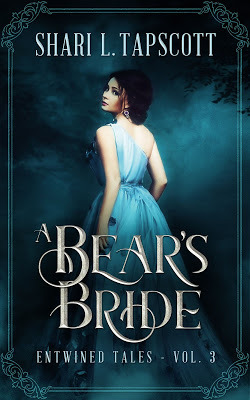
A Bear's Bride was a short, choppy, and mostly harmless adaptation of "East of the Sun, West of the Moon," featuring Sophie, the third oldest daughter of the fairy godfather-cursed family. The ending of An Unnatural Beanstalk in which Eva was worried that Sophie would do something rash upon learning that her father wanted to marry her off to a boring farmer led straight into the beginning of this book. In An Unnatural Beanstalk, Sophie was said to have a reputation of calling upon Mortimer, her family's bumbling fairy godfather, far more than any of her siblings. She follows suit by immediately asking him to help her get out of her arranged marriage. He transports her to the castle of a prince named Henri who gets along with her immediately, and they get married. Considering how many problems Mortimer's gifts cause Sophie's siblings in the other books, this one did a pretty sloppy job of incorporating his character. His magic never actually ends up harming Sophie, as the troll queen is the sole cause of all of her and Henri's problems.
The biggest issue I had with A Bear's Bride is its pacing. It's very sloppy. I might have forgiven it if it was one of the longer books in the series and the author wanted to keep it at novella length, but it's actually the shortest next to A Goose Girl , which was paced much better. It is also the only one that ended with a sample chapter of one of the author's other works that was completely unrelated to Entwined Tales, which felt a little self indulgent to me. The worst pacing problem is that Sophie and Henri got married less than halfway through the book, so it felt like there was absolutely no buildup to their relationship. Unlike the fairy tale, she didn't even see him as a polar bear until a decent amount of time after their wedding, which seemed weak because she already knew how handsome he was by then. You wouldn't have Beauty meet the Beast as a prince and then have him tell her "Oh, by the way, I turn into this monster sometimes, but you don't have to look at me when I'm like that because I know you like me better like this." Yet, that's exactly what this book does. Sophie already has her handsome prince and she just looks at him in his bear form later out of sheer curiosity.
I will say that the book's one saving grace is Princess Ambrosia, the daughter of the troll queen who punishes Sophie for the unforgivable crime of kissing her own husband. It hadn't even been established at that point that they had never kissed until it became part of the plot. Ambrosia was Henri's reluctant bride and captor who was all too willing to help Sophie save him from her mother's wrath because she had no desire to marry him. She was a very comedic character, much like Davina from A Goose Girl and Rapunzel from An Inconvenient Princess , causing this book to fit the tone of the series better than An Unnatural Beanstalk, despite not being written as well. It was a lot of fun reading about Ambrosia's antics to get out of her arranged marriage without particularly caring about Sophie's well-being in the process. She was fun and hilarious, and I think the book would have been a lot more interesting if it had been told from her perspective. Her mother, Amara, was a pretty bland villain, but Ambrosia made it all worthwhile.
Even though A Bear's Bride was my least favorite of the Entwined Tales, I wouldn't say it was an unpleasant read. It was just bland and held little substance. It kept up with the tone of the overall series, despite working with an unpopular fairy tale and making little use of Mortimer's bumbling. It could have been more enjoyable if the pacing were better and it had stayed closer to the source material with Sophie not knowing what Henri looked like as a man. I would only recommend this book to hardcore fairy tale fanatics or completionists who want to read every book in the Entwined Tales series. Otherwise, it's safe to skip over this one.

A Bear's Bride was a short, choppy, and mostly harmless adaptation of "East of the Sun, West of the Moon," featuring Sophie, the third oldest daughter of the fairy godfather-cursed family. The ending of An Unnatural Beanstalk in which Eva was worried that Sophie would do something rash upon learning that her father wanted to marry her off to a boring farmer led straight into the beginning of this book. In An Unnatural Beanstalk, Sophie was said to have a reputation of calling upon Mortimer, her family's bumbling fairy godfather, far more than any of her siblings. She follows suit by immediately asking him to help her get out of her arranged marriage. He transports her to the castle of a prince named Henri who gets along with her immediately, and they get married. Considering how many problems Mortimer's gifts cause Sophie's siblings in the other books, this one did a pretty sloppy job of incorporating his character. His magic never actually ends up harming Sophie, as the troll queen is the sole cause of all of her and Henri's problems.
The biggest issue I had with A Bear's Bride is its pacing. It's very sloppy. I might have forgiven it if it was one of the longer books in the series and the author wanted to keep it at novella length, but it's actually the shortest next to A Goose Girl , which was paced much better. It is also the only one that ended with a sample chapter of one of the author's other works that was completely unrelated to Entwined Tales, which felt a little self indulgent to me. The worst pacing problem is that Sophie and Henri got married less than halfway through the book, so it felt like there was absolutely no buildup to their relationship. Unlike the fairy tale, she didn't even see him as a polar bear until a decent amount of time after their wedding, which seemed weak because she already knew how handsome he was by then. You wouldn't have Beauty meet the Beast as a prince and then have him tell her "Oh, by the way, I turn into this monster sometimes, but you don't have to look at me when I'm like that because I know you like me better like this." Yet, that's exactly what this book does. Sophie already has her handsome prince and she just looks at him in his bear form later out of sheer curiosity.
I will say that the book's one saving grace is Princess Ambrosia, the daughter of the troll queen who punishes Sophie for the unforgivable crime of kissing her own husband. It hadn't even been established at that point that they had never kissed until it became part of the plot. Ambrosia was Henri's reluctant bride and captor who was all too willing to help Sophie save him from her mother's wrath because she had no desire to marry him. She was a very comedic character, much like Davina from A Goose Girl and Rapunzel from An Inconvenient Princess , causing this book to fit the tone of the series better than An Unnatural Beanstalk, despite not being written as well. It was a lot of fun reading about Ambrosia's antics to get out of her arranged marriage without particularly caring about Sophie's well-being in the process. She was fun and hilarious, and I think the book would have been a lot more interesting if it had been told from her perspective. Her mother, Amara, was a pretty bland villain, but Ambrosia made it all worthwhile.
Even though A Bear's Bride was my least favorite of the Entwined Tales, I wouldn't say it was an unpleasant read. It was just bland and held little substance. It kept up with the tone of the overall series, despite working with an unpopular fairy tale and making little use of Mortimer's bumbling. It could have been more enjoyable if the pacing were better and it had stayed closer to the source material with Sophie not knowing what Henri looked like as a man. I would only recommend this book to hardcore fairy tale fanatics or completionists who want to read every book in the Entwined Tales series. Otherwise, it's safe to skip over this one.
Published on July 23, 2018 09:44
July 22, 2018
Disenchantment Has a Trailer!
This has been a pretty good weekend for princess fans. Maleficent II officially began production, and I started a new playlist on my YouTube channel about princess TV shows. The biggest news, however, is that Matt Groening's upcoming Netflix series just dropped its first full-length trailer. I am so excited about Disenchantment, and the trailer did not disappoint. It looks like everything I was hoping it would be. Bean is incredibly easy to relate to. Even though she does turn many of the princess tropes on their head, she still inherently wants to be a good person, which is very important for princess parodies, which can easily lose their focus if they try to be too malicious. I'll let you check out the trailer below before delving into it further.
The first thing we see is Bean's wedding, but just like the opening wedding in ABC's 2015 comedy Galavant, things do not go as expected for our adventuresome heroine. When Bean is given the opportunity to say "I do" for the prince's hand in marriage, she bravely exclaims "No!" and throws her wedding ring on the floor. There have been many other princesses who were forced into unwanted marriages, such as Fiona in Shrek , but they usually wait for their prince to come to rescue them instead of outright refusing and then bravely facing the consequences of their actions. Don Bluth's Thumbelina came the closest to this scenario by refusing to marry Mr. Mole without being aware that Prince Cornelius was already on his way to stop the wedding, but he gave her encouragement indirectly through her memories of him in the visual eye candy that we see reflected in the candles and the engagement ring he gave her at the beginning of the movie.
Even though Bean is a little irreverent when it comes to her royal responsibilities, the most important thing in the trailer is that she still wants to be a good person. I don't think I would be able to tolerate a princess show in which the princess is just as lazy and clueless as Homer Simpson or Fry. When she refuses her groom's hand in marriage and he accidentally falls onto a pile of swords in an attempt to pick her ring up off the floor, she is genuinely shocked by the injuries that were caused by his stupidity and facial expression appears to be torn between wanting to help him and wanting to get away from the ceremony as quickly as possible. Even the admittedly distasteful joke about her saying she makes a good butcher after killing a bunch of animals and learning she was actually in a pet shop was redeemed by her own naivete, as she showed concern and regret when she realized what she had done.
Aside from retaining all of the traits that make princesses great, I love how easy Bean is to relate to. There was one clip from the trailer and another from the teaser in which her father tells her how disappointed he is in her for failing to maintain the grace and class that one would expect from a princess. Her toothy overbite, stubby eyelashes, freckles, and messy platinum white hair are not what you would expect to see on a princess, but like Rapunzel, they make her appearance unique and endearing. Groening has stated in interviews is a bit of drunkard, and that was highlighted in the trailer as well when she was portrayed in a tavern surrounded by an enthusiastic crowd who cheers for her to chug down a fairy, which fortunately flies away unharmed after she finishes her drink. Even though drinking is not a very ladylike activity, it is also one that many older animation fans can relate to. I also like that the show does not encourage her vice. When she asks her companion, Elfo, what this feeling is that she "doesn't want to drink away," he tells her that it's called hope, showing us that she is aware that she has a problem and wishes to improve but doesn't know how.
We also received some samples of the type of humor we can expect to see from Bean's two sidekicks. Her demon friend Luci says that he wants to "get rid of all the diseases plaguing mankind and replace them with worse ones," which is exactly the sort of joke one might find in one of Groening's other shows. Elfo's humor appears to come from his sheer stupidity when a woman falls in the water screaming "I'm drowning!" and he responds "I'm Elfo!" and again later when he fails to follow Bean's advice to avoid falling down a large waterfall. I'm looking forward to having a lot of laughs when this show premieres on Netflix on August 17th, but I'm also looking forward to having an older princess who is inherently flawed but whose heart is always in the right place.
The first thing we see is Bean's wedding, but just like the opening wedding in ABC's 2015 comedy Galavant, things do not go as expected for our adventuresome heroine. When Bean is given the opportunity to say "I do" for the prince's hand in marriage, she bravely exclaims "No!" and throws her wedding ring on the floor. There have been many other princesses who were forced into unwanted marriages, such as Fiona in Shrek , but they usually wait for their prince to come to rescue them instead of outright refusing and then bravely facing the consequences of their actions. Don Bluth's Thumbelina came the closest to this scenario by refusing to marry Mr. Mole without being aware that Prince Cornelius was already on his way to stop the wedding, but he gave her encouragement indirectly through her memories of him in the visual eye candy that we see reflected in the candles and the engagement ring he gave her at the beginning of the movie.
Even though Bean is a little irreverent when it comes to her royal responsibilities, the most important thing in the trailer is that she still wants to be a good person. I don't think I would be able to tolerate a princess show in which the princess is just as lazy and clueless as Homer Simpson or Fry. When she refuses her groom's hand in marriage and he accidentally falls onto a pile of swords in an attempt to pick her ring up off the floor, she is genuinely shocked by the injuries that were caused by his stupidity and facial expression appears to be torn between wanting to help him and wanting to get away from the ceremony as quickly as possible. Even the admittedly distasteful joke about her saying she makes a good butcher after killing a bunch of animals and learning she was actually in a pet shop was redeemed by her own naivete, as she showed concern and regret when she realized what she had done.
Aside from retaining all of the traits that make princesses great, I love how easy Bean is to relate to. There was one clip from the trailer and another from the teaser in which her father tells her how disappointed he is in her for failing to maintain the grace and class that one would expect from a princess. Her toothy overbite, stubby eyelashes, freckles, and messy platinum white hair are not what you would expect to see on a princess, but like Rapunzel, they make her appearance unique and endearing. Groening has stated in interviews is a bit of drunkard, and that was highlighted in the trailer as well when she was portrayed in a tavern surrounded by an enthusiastic crowd who cheers for her to chug down a fairy, which fortunately flies away unharmed after she finishes her drink. Even though drinking is not a very ladylike activity, it is also one that many older animation fans can relate to. I also like that the show does not encourage her vice. When she asks her companion, Elfo, what this feeling is that she "doesn't want to drink away," he tells her that it's called hope, showing us that she is aware that she has a problem and wishes to improve but doesn't know how.
We also received some samples of the type of humor we can expect to see from Bean's two sidekicks. Her demon friend Luci says that he wants to "get rid of all the diseases plaguing mankind and replace them with worse ones," which is exactly the sort of joke one might find in one of Groening's other shows. Elfo's humor appears to come from his sheer stupidity when a woman falls in the water screaming "I'm drowning!" and he responds "I'm Elfo!" and again later when he fails to follow Bean's advice to avoid falling down a large waterfall. I'm looking forward to having a lot of laughs when this show premieres on Netflix on August 17th, but I'm also looking forward to having an older princess who is inherently flawed but whose heart is always in the right place.
Published on July 22, 2018 16:38
July 21, 2018
Review: An Unnatural Beanstalk
I finally finished reading the rest of the Entwined Tales series, starting with
An Unnatural Beanstalk
by Brittany Fichter in anticipation of the sequel to her
Autumn Fairy
book,
The Autumn Fairy of Ages
, coming out on Tuesday. I hope to have the rest of my reviews for Entwined Tales up by the end of next week. An Unnatural Beanstalk didn't have the same light-hearted comedic tone as the others in the series, but that wasn't too surprising considering that both of the other books I read by Brittany were pretty dark. It followed the same structure about one of the woodcutter's daughters receiving an unwanted magical gift from her fairy godfather Mortimer and turning her entire life upside-down as a result.
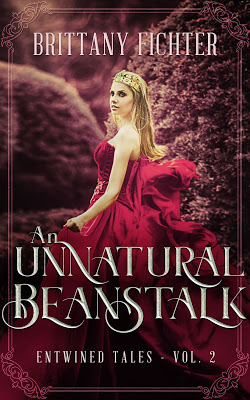
An Unnatural Beanstalk is an adaptation of "Jack and the Beanstalk," but without the fantastical elements from the fairy tale. There are no man-eating giants, no golden eggs, and no beanstalks that tower into the sky. It's quite a shame because those are the elements that made the fairy tale really stand out, and it would have been a lot of fun to read about them from a fresh perspective, especially after the cancellation of Disney's Gigantic. Instead, the book was a pretty generic princess story about an insecure young woman named Eva getting captured by a duke while quietly plotting to unravel his plans to take over the kingdom. Even though the original fairy tale had no romance in it, Jack got demoted to the role of the protagonist's love interest in this version. Though he attempts to come to Eva's rescue upon learning that she was kidnapped, it proves to be far more difficult than he expected.
Eva's unwanted gift from Mortimer to grow or destroy crops when she plays the harp becomes a crucial factor in the duke's plan. He forces her to play his harp every morning and night to ensure that his land would be fruitful while simultaneously killing the crops for the rest of the kingdom. The concept of a peasant girl being forced to do something magical by a powerful man hearkens to the story of "Rumpelstiltskin." In fact, the fairy tale about an unwanted magical gift to spin straw into gold creating misfortune for the main character would have fit a lot better with the overarching theme of the Entwined Tales series than "Jack and the Beanstalk," so I'm a little surprised that nobody used it. Though Eva's story is rather generic as far as fairy tales go, she did have a few traits that made her unique. She was uncommonly tall for a girl, which made it difficult for her to find a suitor, and her insecurities made it hard for her to stand up for herself. Because of her uncommon humility, she never summoned her irritable fairy godfather Mortimer to request his faulty magic, making her his "favorite" of the woodcutter's children.
The book seemed to be a thinly veiled cautionary tale about bad parenting. Both of the main characters' problems were caused by poor parenting decisions. Eva was sent away to live with her nefarious cousin, Tamra, as her parents' way of "protecting" her from people who might take advantage of her supernatural abilities. It was later revealed that the duke who kidnapped Eva was raised by the type of parents who believed in participation trophies and constant praise, making him oblivious to the negative consequences of his actions. The duke was the closest attempt that the book made at humor with his awful poetry and his complete lack of awareness that Eva did not return his affections, but her situation was so grim that the tone never felt as light as the rest of the Entwined Tales series. If anything, his black humor was comparable to Count Olaf from A Series of Unfortunate Events. Jack's mother was also every bit as cold and demanding as she was in the original fairy tale, which is why he was the first person to notice Eva's humility and kindness and quickly grew to love her. Brittany Fichter even included a bonus chapter for subscribers to her newsletter about how much of an unwanted ruckus Jack's mother caused after he and Eva were trying to enjoy their happy ending. Though the bonus chapter had a lot of typographical errors, it was funnier than the actual book in many ways because it satirized overbearing mothers.
An Unnatural Beanstalk created a lot of untapped potential by excluding the giants and the magical kingdom in the sky from the story it was based on. Thanks to the lack of whimsy, I found it less creative than the other books in the series and by far the darkest. The plot was very similar to every other princess book I've read. That said, Jack and Eva were likable enough as characters, and the romance between them was endearing. I saw many parallels to Brittany's other novel, The Autumn Fairy, but I liked that book a lot more thanks to its fantasy and originality. The message about bad parenting was enforced a little too much. It seemed as if all of the characters' problems could have been solved with better parents whether Mortimer's magic had been part of the story or not. It was an enjoyable enough book, but not the best in the series.

An Unnatural Beanstalk is an adaptation of "Jack and the Beanstalk," but without the fantastical elements from the fairy tale. There are no man-eating giants, no golden eggs, and no beanstalks that tower into the sky. It's quite a shame because those are the elements that made the fairy tale really stand out, and it would have been a lot of fun to read about them from a fresh perspective, especially after the cancellation of Disney's Gigantic. Instead, the book was a pretty generic princess story about an insecure young woman named Eva getting captured by a duke while quietly plotting to unravel his plans to take over the kingdom. Even though the original fairy tale had no romance in it, Jack got demoted to the role of the protagonist's love interest in this version. Though he attempts to come to Eva's rescue upon learning that she was kidnapped, it proves to be far more difficult than he expected.
Eva's unwanted gift from Mortimer to grow or destroy crops when she plays the harp becomes a crucial factor in the duke's plan. He forces her to play his harp every morning and night to ensure that his land would be fruitful while simultaneously killing the crops for the rest of the kingdom. The concept of a peasant girl being forced to do something magical by a powerful man hearkens to the story of "Rumpelstiltskin." In fact, the fairy tale about an unwanted magical gift to spin straw into gold creating misfortune for the main character would have fit a lot better with the overarching theme of the Entwined Tales series than "Jack and the Beanstalk," so I'm a little surprised that nobody used it. Though Eva's story is rather generic as far as fairy tales go, she did have a few traits that made her unique. She was uncommonly tall for a girl, which made it difficult for her to find a suitor, and her insecurities made it hard for her to stand up for herself. Because of her uncommon humility, she never summoned her irritable fairy godfather Mortimer to request his faulty magic, making her his "favorite" of the woodcutter's children.
The book seemed to be a thinly veiled cautionary tale about bad parenting. Both of the main characters' problems were caused by poor parenting decisions. Eva was sent away to live with her nefarious cousin, Tamra, as her parents' way of "protecting" her from people who might take advantage of her supernatural abilities. It was later revealed that the duke who kidnapped Eva was raised by the type of parents who believed in participation trophies and constant praise, making him oblivious to the negative consequences of his actions. The duke was the closest attempt that the book made at humor with his awful poetry and his complete lack of awareness that Eva did not return his affections, but her situation was so grim that the tone never felt as light as the rest of the Entwined Tales series. If anything, his black humor was comparable to Count Olaf from A Series of Unfortunate Events. Jack's mother was also every bit as cold and demanding as she was in the original fairy tale, which is why he was the first person to notice Eva's humility and kindness and quickly grew to love her. Brittany Fichter even included a bonus chapter for subscribers to her newsletter about how much of an unwanted ruckus Jack's mother caused after he and Eva were trying to enjoy their happy ending. Though the bonus chapter had a lot of typographical errors, it was funnier than the actual book in many ways because it satirized overbearing mothers.
An Unnatural Beanstalk created a lot of untapped potential by excluding the giants and the magical kingdom in the sky from the story it was based on. Thanks to the lack of whimsy, I found it less creative than the other books in the series and by far the darkest. The plot was very similar to every other princess book I've read. That said, Jack and Eva were likable enough as characters, and the romance between them was endearing. I saw many parallels to Brittany's other novel, The Autumn Fairy, but I liked that book a lot more thanks to its fantasy and originality. The message about bad parenting was enforced a little too much. It seemed as if all of the characters' problems could have been solved with better parents whether Mortimer's magic had been part of the story or not. It was an enjoyable enough book, but not the best in the series.
Published on July 21, 2018 12:02
July 16, 2018
New Release Date and Concept Art for She-Ra and the Princesses of Power!
Last December, we were all eagerly anticipating news about the upcoming reboot of She-Ra: Princess of Power under the slightly different title of She-Ra and the Princesses of Power. Today, that wish has finally been granted! The show's official Facebook page was just updated with a new interview from showrunner Noelle Stevenson as well as some concept art that gives us an idea of the look and feel that the new Netflix series will have. As if that wasn't enough excitement for one day, there's also a release date, which is something I knowI've been wondering about for a while. She-Ra and the Princesses of Power is scheduled for broacast on Netflix on Friday, November 16th! Are you as excited as I am?
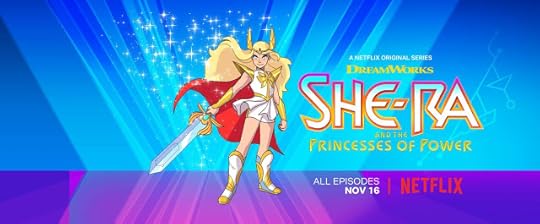
The new design for She-Ra appears to be more whimsical and loose than the original with more of a focus on movement lines than the stiff straight-edged style of the '80s. Her heroic stance and flowing hair, cape, and skirt imply that the series will be action-packed with a lot of fluid motion. She looks quite a bit younger than the voluptuous woman from the '80s series, who appeared to be in her late '30s. This version of Princess Adora has a more age-appropriate design for her fan base as a badass teen with little to no focus on sex appeal and a great deal of focus on empowerment toward girls in a similar vibe to DC Superhero Girls. The overall style of animation looks like a cross between the 2008 Spectacular Spider-Man series and the ongoing Steven Universe series from Cartoon Network.

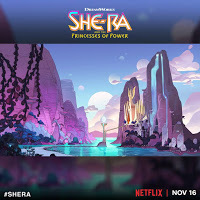
My favorite thing about the newly released concept art is the vibrant colors that were used in the backgrounds. The gorgeous image of Princess Adora's kingdom featured above looks like it could easily be swapped out for an episode of Tangled. I also love the colorful costume designs for Adora's friends pictured below that seem to pop right out of the screen in bright shades of red and purple. Adora is very expressive in all of the images, which promises that she will be a relatable character and that the series will offer a fair amount of drama to keep things interesting. The '80s show had a pretty generic storyline overall, so this promises to be a great turn of events for an updated version. Her superhero costume and street clothes are both similar enough to pay loyalty to the original but unique enough to match today's style of animation.
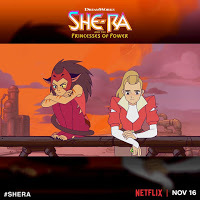
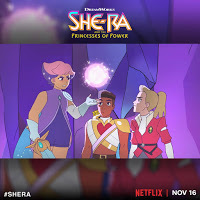
According to the interview with Noelle Stevenson, the series will follow the same backstory as the original, in which Adora is raised by an evil overlord named Hordak to believe that evil is the correct way of life and that princesses are in the wrong before learning the truth and transforming into She-Ra. It aligns right up with modern princess culture in which princesses are brave adventurers who fight for justice and are rarely evil. I'm sure it's no coincidence, then, that this new version of She-Ra is voiced by

The new design for She-Ra appears to be more whimsical and loose than the original with more of a focus on movement lines than the stiff straight-edged style of the '80s. Her heroic stance and flowing hair, cape, and skirt imply that the series will be action-packed with a lot of fluid motion. She looks quite a bit younger than the voluptuous woman from the '80s series, who appeared to be in her late '30s. This version of Princess Adora has a more age-appropriate design for her fan base as a badass teen with little to no focus on sex appeal and a great deal of focus on empowerment toward girls in a similar vibe to DC Superhero Girls. The overall style of animation looks like a cross between the 2008 Spectacular Spider-Man series and the ongoing Steven Universe series from Cartoon Network.


My favorite thing about the newly released concept art is the vibrant colors that were used in the backgrounds. The gorgeous image of Princess Adora's kingdom featured above looks like it could easily be swapped out for an episode of Tangled. I also love the colorful costume designs for Adora's friends pictured below that seem to pop right out of the screen in bright shades of red and purple. Adora is very expressive in all of the images, which promises that she will be a relatable character and that the series will offer a fair amount of drama to keep things interesting. The '80s show had a pretty generic storyline overall, so this promises to be a great turn of events for an updated version. Her superhero costume and street clothes are both similar enough to pay loyalty to the original but unique enough to match today's style of animation.


According to the interview with Noelle Stevenson, the series will follow the same backstory as the original, in which Adora is raised by an evil overlord named Hordak to believe that evil is the correct way of life and that princesses are in the wrong before learning the truth and transforming into She-Ra. It aligns right up with modern princess culture in which princesses are brave adventurers who fight for justice and are rarely evil. I'm sure it's no coincidence, then, that this new version of She-Ra is voiced by
She’s separated from her family as a baby, she’s sent to another planet, she’s adopted by the villain overlord and raised by him in this evil army. She’s been raised to believe that the villains are doing the right thing and that the Princesses are the evil ones.Personally, I have never been a fan of the stiff rudimentary animation style of the '80s and the episodic story structure where everything resets at the end of each episode. I love the idea of She-Ra: Princess of Power, but watching it was difficult for me because it was so dated by the time I decided to check it out. She-Ra and the Princesses of Power looks like a breath of fresh air with the same timeless concept applied to modern fluid animation and storytelling. I wish I didn't have to wait another four months before I can see it come to life, but I'm eager to learn where Adora's journey will take me.
Published on July 16, 2018 12:47



